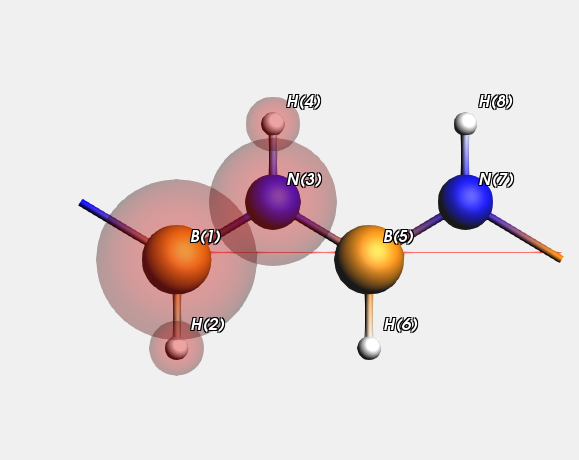Example: Using capping atoms in a periodic system with charges¶
Now we look at a BN chain and use charges for the MM calculation.

Let us have a look at the report generated by the example, that pretty much explains what is done
Download report PeriodicCappingWithCharges.txt
We optimize the lattice and test several distances.
We divide the system in such a way that there are two equivalent, and hence neutral regions.
Here are the distances (Angstrom) as obtained with a QM and an MM method:
Distance QM MM Err(MM)
-------------------------------------------
B-H 1.182 1.181 -0.001
N-H 1.007 1.042 0.034
B-N 1.431 1.499 0.068
Of course the force field results do not exactly match the QM results, the error displayed in the last column.
Now we try the hybrid engine, can we improve the bonds in the QM region?
We start from the geometry calculated with the (cheap) forcefield.
In this table we show the errors in bond lengths (in the QM region) of the hybrid method with respect to the QM method:
Embedding Capping Energy B-H N-H B-N
-------------------------------------------------------------------------
mechanical fixed -6.844721 0.004 -0.007 -0.044
mechanical fractional -6.745243 0.012 -0.007 -0.042
electrostatic fixed -6.749110 0.002 -0.004 -0.036
electrostatic fractional -6.652361 0.010 -0.004 -0.026
Here are some observations
* the B-H distance is a bit worse than with a plain forcefield, especially with fractional capping
* the N-H distance is much better than with the plain forcefield
* the B-N distance is a bit better than with the plain forcefield, now too short. Fractional capping works best.
* Electrostatic embedding is doing slightly better than mechanical embedding, the biggest improvement is on the B-N bond
Note that this example makes use of the python scripting tools PLAMS and PISA, available in the AMS Python Stack.
Download PeriodicCappingWithCharge.py
#!/usr/bin/env amspython
from scm.libbase import ChemicalSystem, Units
from scm.input_classes import drivers, engines
from scm.plams import AMSJob, JobRunner, config, Settings
import os
import copy
# Load molecule and run initial geometry optimization
config.default_jobrunner = JobRunner(parallel=True)
settings = Settings()
settings.runscript.nproc = 1
struct_dir = os.path.join(os.getenv("AMSHOME"), "examples", "Hybrid", "PeriodicCapping", "systems")
mol = ChemicalSystem.from_xyz(os.path.join(struct_dir, "var5.xyz"))
mol.guess_bonds()
driver_geom_opt = drivers.AMS()
driver_geom_opt.Task = "GeometryOptimization"
driver_geom_opt.Engine = engines.DFTB()
driver_geom_opt.GeometryOptimization.OptimizeLattice = True
driver_geom_opt.GeometryOptimization.Method = "FIRE"
driver_geom_opt.GeometryOptimization.MaxIterations = 300
job_dftb = AMSJob(molecule=mol, settings=settings + Settings({"input": driver_geom_opt}), name="reference")
results_dftb = job_dftb.run()
# Get charges and add them to molecule
mol.enable_atom_attributes("forcefield")
charges = results_dftb.get_charges()
for atom, charge in zip(mol.atoms, charges):
atom.forcefield.charge = charge
# Run cheap calculation using forcefield engine
driver_geom_opt.Engine = engines.ForceField()
driver_geom_opt.Engine.NonBondedCutoff = 50 * Units.conversion_factor("bohr", "angstrom")
job_ff = AMSJob(molecule=mol, settings=settings + Settings({"input": driver_geom_opt}), name="cheap")
results_ff = job_ff.run()
mol = results_ff.get_main_system()
print("begin report")
print(
"""We optimize the lattice and test several distances.
We divide the system in such a way that there are two equivalent, and hence neutral regions.
Here are the distances (Angstrom) as obtained with a QM and an MM method:
"""
)
header = "{:<10} {:>10} {:>10} {:>10}".format("Distance", "QM", "MM", "Err(MM)")
print(header)
print("-" * len(header))
mol_qm = results_dftb.get_main_system()
mol_mm = results_ff.get_main_system()
for bond, i, j in [("B-H", 0, 1), ("N-H", 2, 3), ("B-N", 0, 2)]:
dist_qm = mol_qm.get_distance(i, j)
dist_mm = mol_mm.get_distance(i, j)
print(f"{bond:<10} {dist_qm:>10.3f} {dist_mm:>10.3f} {dist_mm - dist_qm:>10.3f}")
# Run hybrid engine
results = {}
for embedding in ["mechanical", "electrostatic"]:
for capping in ["fixed", "fractional"]:
driver = copy.deepcopy(driver_geom_opt)
driver.Properties.Gradients = True
driver.GeometryOptimization.MaxIterations = 100
driver.Engine = engines.Hybrid()
driver.Engine.Capping.AllowHighBondOrders = True
driver.Engine.Capping.Option = capping
driver.Engine.QMMM.QMRegion = "qm"
driver.Engine.QMMM.QMEngineID = "DFTB"
driver.Engine.QMMM.MMEngineID = "ForceField"
driver.Engine.QMMM.Embedding = embedding
driver.Engine.Engine[0] = engines.BAND()
driver.Engine.Engine[1] = engines.DFTB()
driver.Engine.Engine[2] = engines.ForceField()
driver.Engine.Engine[2].NonBondedCutoff = 50 * Units.conversion_factor("bohr", "angstrom")
job = AMSJob(
molecule=mol,
settings=settings + Settings({"input": driver}),
name=f"system.embedding={embedding}.capping={capping}.go",
)
results[(embedding, capping)] = job.run()
hybrid_results = {k: (v.get_energy(engine="hybrid"), v.get_main_system()) for k, v in results.items()}
print(
"""Of course the force field results do not exactly match the QM results, the error displayed in the last column.
Now we try the hybrid engine, can we improve the bonds in the QM region?
We start from the geometry calculated with the (cheap) forcefield.
In this table we show the errors in bond lengths (in the QM region) of the hybrid method with respect to the QM method:
"""
)
header = "{:<16} {:>16} {:>12} {:>8} {:>8} {:>8}".format("Embedding", "Capping", "Energy", "B-H", "N-H", "B-N")
print(header)
print("-" * len(header))
for (embedding, capping), (energy, mol_hybrid) in hybrid_results.items():
errs = [mol_hybrid.get_distance(i, j) - mol_qm.get_distance(i, j) for i, j in [(0, 1), (2, 3), (0, 2)]]
print(f"{embedding:<16} {capping:>16} {energy:>12.6f} {errs[0]:>8.3f} {errs[1]:>8.3f} {errs[2]:>8.3f}")
print(
"""Here are some observations
* the B-H distance is a bit worse than with a plain forcefield, especially with fractional capping
* the N-H distance is much better than with the plain forcefield
* the B-N distance is a bit better than with the plain forcefield, now too short. Fractional capping works best.
* Electrostatic embedding is doing slightly better than mechanical embedding, the biggest improvement is on the B-N bond
"""
)
print("end report")